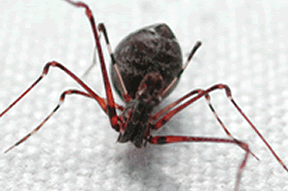

As with many other groups of plants and animals, the spider fauna of Madagascar is most interesting to a biologist.There is a high degree of endemism and the faunal composition is quite different from that in other parts of the world. For instance, the family Halidae is restricted to Madagascar, and Gallieniellidae is largely restricted to this island. Migidae has an endemic subfamily, and Pisauridae (fishing spiders), Heteropodidae (giant crab spiders) and Zorocratidae are very well represented. The family Thomisidae has many endemic genera. Archaeidae are best represented here, as well as having the largest species here.
The classification follows PLATNICK, N.I. 1997. Advances in spider taxonomy, 1992-1995: with redescriptions 1940-1980. New York Entomological Society, 976 pp., except where it is modified to reflect the changes suggested in GRISWOLD, C.E., J.A. CODDINGTON, N. PLATNICK, and R. FORSTER. 1999. Towards a phylogeny of entelegyne spiders (Araneae, Araneomorphae, Entelegynae). J. Arachnol., 27:53-63.Below is a list of species known to occur in Madagascar, although certainly with additional collecting further species will be added to this list. A name in parentheses preceded by an equal sign represents a junior synonym. Not all original descriptions have been consulted yet.
CHARACTERS FOR ENTELEGYNAE MATRIX
In 1999 Griswold, Coddington, Platnick and Forster presented a provisional phylogeny for most entelegyne families with
cribellate members based on a matrix of 137 characters scored for 43 exemplar taxa and analyzed under parsimony. That
phylogeny tested many suprafamilial hypotheses of the last 30 years and was the first attempt to relate them using
quantitative phylogenetic techniques: Amaurobioidea (sensu Forster & Wilton 1973), Amaurobiidae and included subfamilies (sensu Lehtinen 1967), Dictynoidea and Desidae (sensu Forster 1970), Entelegynae (sensu Coddington 1990, Coddington & Levi 1991), Lycosoidea (Homann 1971, sensu Griswold 1993); Orbiculariae (sensu Coddington 1986, 1990a, b); and the 'RTA clade' (sensu Coddington & Levi 1991). That cladogram confirmed some accepted groupings, refuted others, and proposed several novel phylogenetic and nomenclatural changes. Confirmed were the monophyly of Neocribellatae, Araneoclada, Entelegynae, and Orbiculariae. The Lycosoidea, Amaurobiidae and some included subfamilies, Dictynoidea, and Amaurobioidea (sensu Forster & Wilton 1973) proved to be polyphyletic. Phyxelididae Lehtinen was raised to family level and Zorocratidae Dahl, 1913 was revalidated. A group including all other entelegynes other than Eresoidea was weakly supported as the sister group of Orbiculariae and several new, informative, informal clades were proposed or redefined: the "Canoe Tapetum Clade," "Divided Cribellum Clade, the "Titanoecoids," the "RTA Clade," the "Fused Paracribellar Clade," the "Stiphidioids" and the "Agelenoids".
Time and space constraints in the Congress volume made it impossible to present and discuss the data fully. The data were presented as a matrix, and characters and character state descriptions were abbreviated. Here we hope to partially remedy that shortcoming, reproducing the preferred 327 step cladogram, spelling out the characters and their states, presenting images of many states, especially those not previously discussed in the literature, and presenting character state trees derived in MacClade (Maddison & Maddison 1992) on the cladogram. We have made one modification to the data. Character 56, epiandrous spigots present or absent, was inadvertently miscoded for as present in Maniho, Metaltella, Matachia, Badumna c. and Badumna l. These spigots are absent in these taxa. When correctly scored the same tree, needing one less step (326), was preferred under the same search strategies employed in the original analysis. We don't intend to present a new analysis here, although continuing discoveries have called some homologies into question. A large paper is in preparation that presents depicts many of the new data and discusses in detail the characters, their states, and the implications of the cladogram for their evolution. We hope that the 1999 analysis, this web publication, and the large paper in preparation will provide a springboard to further, more detailed and/or more comprehensive analyses of araneomorph phylogeny.
Last Updated January 2009